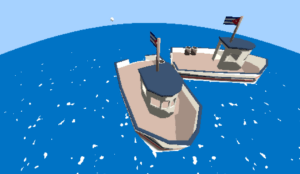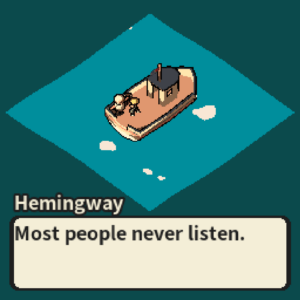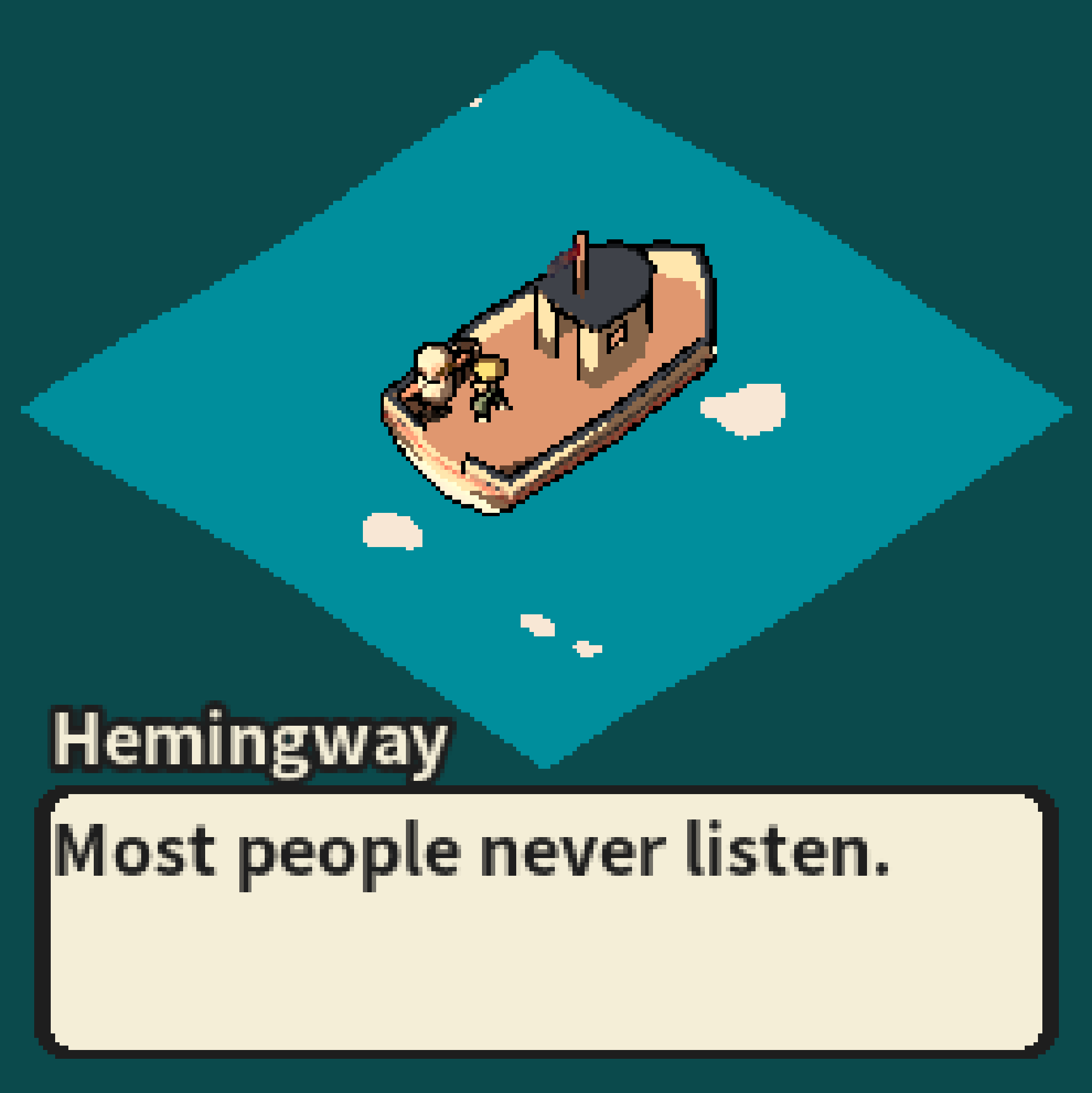VVVVVVVVVVVVVVVVVVVVVVVVVVVVVVVVVV
CLICK TO PLAY: https://lizardking260.itch.io/old-man-and-the-sea
^^^^^^^^^^^^^^^^^^^^^^^^^^^^^^^^^^^
You are on a boat with Hemingway. And what do you do when you’re on a boat with someone? You shoot the shit, talk about life. Old Man and the Sea has a very relaxing atmosphere. It has four songs and four times of day that change as you speak with Hemingway. The game puts no pressure on the player to do anything, it is meant to be a relaxing experience you can sink into with minimal friction.
My initial idea was to create a “choiceless choice-based” game (because I like making things harder on myself than they need to be). I had an ambitious idea for a branching narrative but with too much momentum for the player to escape their fate. Hemingway would hold you on his boat and would not allow you to go back to land, no matter how many times you asked or what you did to try and escape. Eventually you would end up joining Che Guevara in Africa and dying in combat, through no fault of your own.
As I worked on P2, I gradually simplified this idea until I landed on an admittedly experimental experience. At first it may seem like the player has no choices; all they “can do” is speak to Hemingway or drive the boat (though there is nowhere to go). I spent a lot of time thinking about the types of choices that matter to me in games. I reflected on one of my favorite games of all time, Skate 3. It has a game mode, Free Skate, where you freely skate around the map, doing tricks, if you want, on any interesting feature you find. A lot of times I would go home after school, turn on Skate 3, leave my player idling in a scenic location, and listen to the Skate 3 soundtrack as I worked on homework, glancing at the TV every so often. For me, the single most meaningful choice a game can give is the pace of play. I love it when a game removes all the timers, enemies, combat, risk, etc. and leaves you with a deliciously atmospheric world that can be enjoyed just as much by speedrunning through it than by doing nothing at all. For Old Man and the Sea, I tried to make a game like this. The final product reminds me of when I was a kid playing Pokemon and I’d meet an interesting NPC with a lot of text lines and I would spend a few minutes reading what they had to say.
A lot of the initial testing I did was to evaluate the game’s atmosphere. I made a few different audiovisual vignettes to understand how people felt when experiencing them. I landed on a GameBoy-esque retro style with atmospheric visuals and futuristic Spanish guitar music. I would not have landed on such a cozy, moody vibe without playtesting.
Another way that playtesting helped me achieve a better game is in refining my writing style. From playtesting I realized people gloss over long sentences and are overwhelmed by large amounts of text on screen. I took these reactions and brutally reduced the amount of text on screen to two lines of chunky GBA text. This aligns stylistically with Hemingway’s quick and terse writing style, immersing the player further into the experience.
All in all, thanks to playtesting and iteration I was able to achieve a meditative and relaxing experience which doesn’t put pressure on the player. Next I will relate specific feedback to how it informed changes I made…
1) From sharing my “paper prototype” for the original (much more complex) game I envisioned, I received feedback about what expectations the player would have for the experience. The playtester said they expected things like a fishing minigame, a combat minigame, exploration of areas with the boat, and more. From this feedback, I determined I needed to brutally reduce the scope of the game and create a primarily text-based and atmospheric experience.


2) I showed multiple people two different visual iterations of the game. Screenshots are provided above. For the “round world” version, they shared they’d expect this game to involve exploration since the roundedness of the world provided a seemingly far field of view. For the “diamond world” version (which I ended up using), one playtester said it was “bad” because it provided very little long-distance visibility; however, they admitted it had a certain aesthetic charm. They are right it provides little visibility but I decided this was a good thing. Long-distance visibility is completely irrelevant to the point of this game and the implication of a small and intimate setting is very useful for creating a cozy and moody atmosphere.
3) In terms of writing style, I showed excerpts of writing to playtesters. Some playtesters indicated Hemingway’s terse writing style could (and perhaps should) be reflected in the writing of the game. Otherwise, playtesters were overwhelmed by large amounts of text on screen. These pieces of feedback led to me limiting myself to very short sentences and a small on-screen text box.
For Old Man and the Sea I sought out to create a minimalistic “smelling the flowers” type of experience. Enjoy the music, the colors, the reading, etc. Subjectively, I enjoy the final project and have found myself playing it in the background as I multi-tasked on other things. I learned that good writing can pull a lot of weight when it comes to game design; previously I created exclusively action/system based games so this was a refreshing change. Next time I will make a game with more characters and areas; I think the stylistic choices from this game can extend to a more complex experience.
P.S. u can drive de boat




I think the biggest value I took from this game was simply appreciation. Looking at the visual, while listening to the music and reading what the Old Man was saying created an almost meditative atmosphere. It was a very submissive type of fun. After reading Alejandro’s documentation, I can see that his past really helped him decide why he wanted to focus on this value. I really like atmospheric games like that, or games that allow me to just enjoy the sensations while not having to worry about things like XP or obtaining the best upgrades and such.
A recent game I’ve played that invoked the same type of feelings that Alejandro’s game did is a game called Melatonin, a rhythm game. And while it can get hectic at times trying to stay on beat, similar to Alejandro, you had WASD controls to move from level to level and then when playing the actual level, there was only one button, the spacebar, that you had to click in time with the beat. I think the design choice to keep controls so simply added to the overall relaxed atmosphere the game was trying to promote. I think Alejandro did well to use Godot’s capabilities in order to create this experience. You can’t help but be put at ease with the retro visual style of the game.
I think it was interesting that while there were no choices in the dialogue, you still had the choice of stopping in between the Old Man’s story and driving the boat around. Initially I drove around thinking I might come across something, but after a while, I started driving just to enjoy the new color scheme and music when the scene would slightly change. I really appreciated the pauses in between his story as it reminded me to stop and take in any changes if there were any. One thing Alejandro could improve on is maybe at the end, when the Old Man floats away, either add more NPCs that sort of land on the boat that you could listen to, or have the color scheme and music change on a timer to take it all in once more. Awesome game and Godot is awesome!